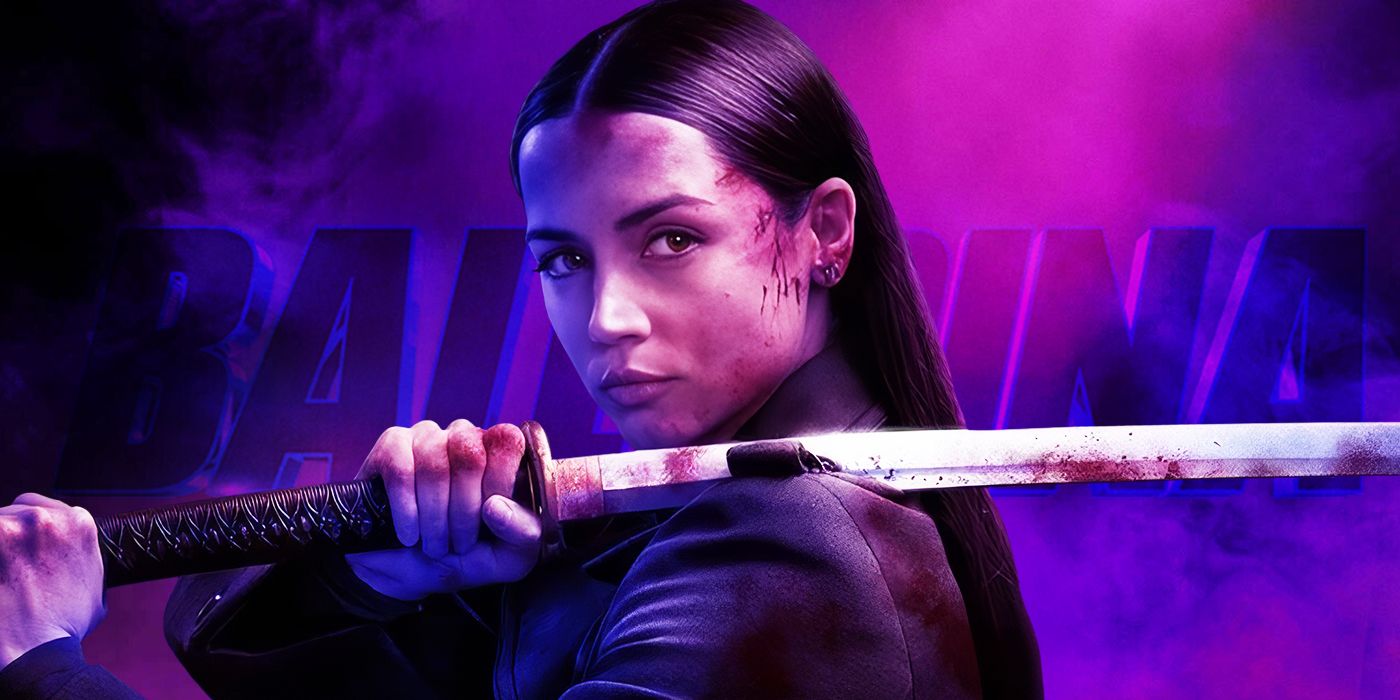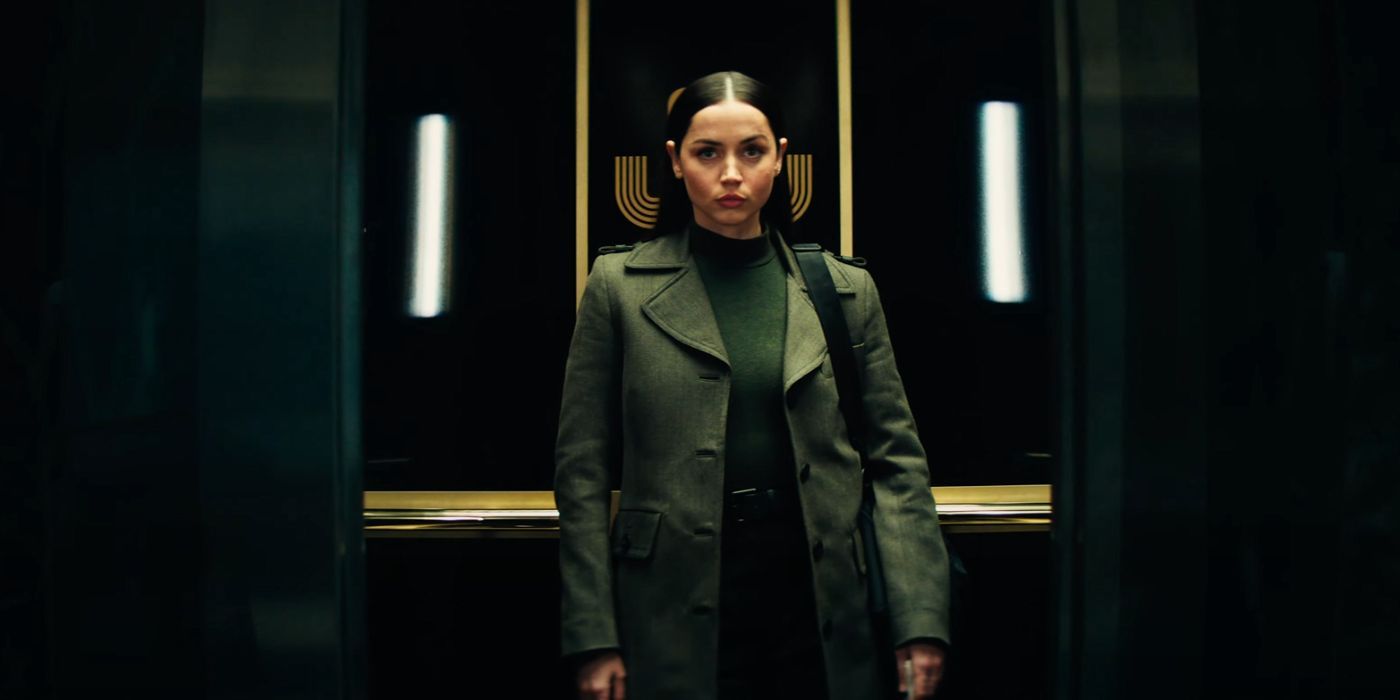In Ballerina, Ana de Armas’ Eve is a Ruska Roma assassin trainee, just like John Wick (Keanu Reeves) before her. In fine John Wick franchise tradition, the film introduces new groups under the High Table—or at least within the High Table’s reach—and, from that, a handful of individual characters. Eve’s primary antagonist is The Chancellor (Gabriel Byrne), who isn’t exactly as fleshed out with motivations or quirks as antagonists of John Wick past, but this is a new story—one that will stretch the scope of those core four films. But The Chancellor’s comparatively thin development has, as John might say, consequences.
Ballerina faces doubts about female-led action head-on. Ballet dojo trainer, Nogi (Sharon Duncan-Brewster), confronts Eve about men overrunning her in sparring sessions—“You will always be weaker, you will always be smaller. […] Improvise. Adapt. Cheat. Fight like a girl.” It’s a shame, then, that the newly introduced Lena (Catalina Sandino Moreno) falls so flat, largely as a consequence of how clumsily the antagonist is executed. Lena is Eve’s older sister, estranged from her early enough in life that Eve doesn’t remember her. She’s a bit of a Chekov’s gun—a big sister is mentioned by Eve’s father in the film’s opening. But in this metaphor, Chekov’s gun is jammed. It’ll come back, but it’s never going off. In a series that has well-defined female characters, including The Director (Anjelica Huston), who lends her authority to this new story, Ballerina gives one of its flattest.
‘Ballerina’ Gives Lena an Introduction That’s Shaky at Best
John Wick is symbolic and mythological, as everything from coins and costumes to a character’s response to High Table representatives or simply the mention of the High Table provides important context. Lena exemplifies how deeply Ballerina abandons those tools. The Chancellor and his cult are ill-defined, so Lena doesn’t get the benefit of established lore. What makes the cult more brutal than the High Table? Well, there are no examples. In a franchise that has perfected the “show, don’t tell,” method, Ballerina sure does tell. But it largely just repeats that Eve’s father was murdered—no one even spoon-feeds the audience the cult’s crimes, the reason for the X brands on their wrists, or The Chancellor’s actual familial role in their lives. So it’s miles away from having the rich context or visual language that characters like Akira (Rina Sawayama) or Katia (Natalia Tena) jumped off from.

Related
Yeah, I’m thinking he’s back (again).
The film introduces us to Lena in the sleek lobby of the Prague Continental, as she blends into the underworld gig economy. The camera lingers on her a bit longer than the more disposable hotel guests, similar to the framing of Perkins (Adrianne Palecki) in the first John Wick. She’s here about Daniel Price (Norman Reedus), the same man Winston (Ian McShane) has suggested is a lead for Eve, as she’s on the hunt to find the cult that killed her father. Or rather, their father. Lena is still in the cult that killed both of their parents.
Where Perkins has her mission in John Wick that leads to one-on-one combat with the Baba Yaga himself and clear motivations, Lena has a radio. Lena chats with an assassin—played by franchise staple Daniel Bernhardt—who has Price’s room in sniper sight. Scenes cut between Eve’s discussion with Price and Lena’s discussion with the Sniper, but Lena doesn’t even have the narrative function of providing information to viewers. And as the film unfolds onto Lena’s home turf, it doesn’t give her more to do.
Hallstatt Fails To Define the Cult, Lena, or Her Shared Trauma With Eve
Once Eve makes it to Hallstatt—the village headquarters for the cult—Lena’s characterization still fails to come to fruition. The film’s repetitive exposition makes it obvious, far past the point of dramatic irony, that Eve’s mother belonged to the cult, and that her father, Javier (David Castañeda), taking her away led to her death. Even those who watch John Wick purely for the sonic pleasure of gunshots and grunts couldn’t miss it. It’s unsurprising to us when The Chancellor says that “fate is humbling” and Lena tells Eve they’re sisters. But it isn’t a character moment either.
Lena shares that she wondered why their father took Eve but not her and mentions that it might be because Eve had not yet taken a life. Lena repeats that their mother paid the price for their father leaving; however, this doesn’t resonate with the existing lore, and the film offers none. She dies minutes later, in the arms of a sister who doesn’t remember her, taking with her any memory of their mother. Worse, her fatal injury happens off-screen, so she doesn’t get mythological glory or a memorable kill befitting any Wick antagonist.
‘John Wick’ Should Know Its Audience Better
By contrast, there’s John Wick 2, where Gianna D’Antonio (Claudia Gerini) gets roughly eight minutes. When John shows up to complete Santino’s (Riccardo Scamarcio) hit, Gianna’s response to the inevitability of her death is impactful and memorable. “I lived my life my way. And I’ll die my way” is a short but powerful statement as Gianna takes her life with bladed hairpins. Before this moment, she questions John about his life with Helen and asks him if he fears damnation. In the intimacy around the cathedral-like bath hall, John is honest. “Yes.” And so we know not just who Gianna is, but who she is to John and what she is to the story at large.
In 2025, films need a bit more than saying “fight like a girl”—especially with established symbolism as world-building and writing, women shouldn’t be a topic that sees struggle. In a film that subverted “fridging” with mementos and dogs, it’s sad that the woman-led offshoot does such a bad job with Eve’s female family members, alive or dead. Lena, like their mother, is a plot point with little emotional impact on both viewers and, unfortunately, Eve. Ana de Armas and audiences alike deserve better than a character that could be removed entirely without hurting the story.

